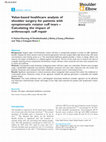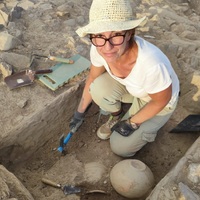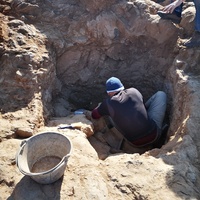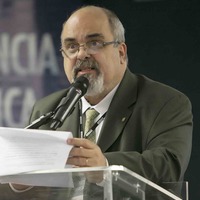Papers by Adel Tavakkolizadeh

Orthopaedic Proceedings, Feb 21, 2018
Tightrope fixation is known method for reconstructing acromioclavicular joint and the presence of... more Tightrope fixation is known method for reconstructing acromioclavicular joint and the presence of good bone stock around the two drillholes is the most important determining factor for preventing failure. Aim Arthroscopic-assisted tightrope stabilisation involve drilling clavicle and coracoids in a straight line. This leads to eccentric drillholes with inadequate bone around it. Open tightrope fixation involves drilling holes under direct vision, independently and leading to centric hole with adequate bone around it. Our study assesses the hypothesis of tightrope fixation in relation to location of drillholes using CT-scan and cadaveric models for arthroscopic and open technique for ACJ fixation. Methods CT-scans of 20 shoulders performed. Special software used to draw straight line from distal end of clavicle to coracoid. Bone volume around coracoid drillhole was calculated. Cadaveric shoulder specimens were dissected. The arthroscopic technique was performed under vision by drilling both clavicle and base of coracoid holes in one direction. Same specimens were used for open technique. Base of coracoid crossectioned and volume calculated. Results 40 shoulders were included(20 cadaveric specimens&20 CT). Bone stock was adequate in both techniques. Variable angle for insertion of drillholes using arthroscopic technique were needed depending on shape of shoulder. Conclusion Tightrope allows nonrigid anatomic fixation of acromioclavicular joint. Published studies showed high rate of fixation failure with tightrope system but with patient satisfaction and high functional results. Our study showed adequate bone stock around coracoid in both open and arthroscopic technique. Mode of failure remains unclear and we recommend further biomechanical studies to assess failure factors

Orthopaedic Proceedings, Sep 1, 2005
Background Tibiotalocalcaneal (TTC) arthrodesis is a salvage procedure for patients with severe d... more Background Tibiotalocalcaneal (TTC) arthrodesis is a salvage procedure for patients with severe disease of the ankle and subtalar joints. Method We report a series of 26 consecutive patients (26 feet) operated on by a single surgeon, in a single centre, over a 4-year period, with average follow up of 26 months (range 6–50). Mean age of the patients was 57 years (range 28–72). Subjects included 17 male and 9 females. Previously the patients had undergone between 0 to 6 operations, which were unsuccessful. All these patients had combined ankle and subtalar joint arthrodesis by an intramedullary nail device. Indications for surgery were pain except the Charcot joints. Only five patients did not have severe deformity pre-operatively. Aetiology included post-traumatic osteoarthritis, rheumatoid arthritis, psoriatic arthropathy, avascular necrosis, Charcot Marie Tooth disease, primary osteoarthritis, failed ankle replacement and alcohol-and diabetic-induced Charcot neuroarthropathy. Patients were assessed radiologically and by American Orthopaedic Foot and Ankle Society (AOFAS) Ankle-Hindfoot Scale, SF-12 and by patient satisfaction scores. Results Clinically and radiologically, 15 cases have solid union. Six patients have signs of radiological non-union/ delayed union but are clinically asymptomatic with no progressive deformity. Two patients required amputation (one non-union and one infected non-union). One patient is awaiting further surgery for infected non-union. Two patients have died of unrelated causes ~2 years post-surgery. Most patients (79%) are very satisfied with the procedure and 83% would undergo the procedure again. Conclusion These results suggest that salvage is possible in the majority of cases with combined ankle and subtalar joint arthrosis and severe deformity.

Orthopaedic Proceedings, May 1, 2012
Introduction Humeral non-union may present a challenging problem. The instability from the un-uni... more Introduction Humeral non-union may present a challenging problem. The instability from the un-united fracture leads to pain, disability and significant morbidity. The incidence of humeral shaft non-union as a complication of both operative and non-operative treatment is approximately 8% to 12%. This retrospective study reviews the results of surgical treatment of humeral fracture non-union performed by a single surgeon with a consistent surgical protocol. Material and Method We present a retrospective analysis of a series of 51 consecutive cases of humeral fracture non-union treated in our limb reconstruction centre. Data were collected on mechanism of injury, associated co-morbidities, smoking, use of NSAIDs and treatment before referral. Patients were followed up to clinical and radiological union. Results From 1994-2008, 48 patients with established humeral non-union were referred to our unit following initial management locally. Three patients were managed in our unit from the outset. There were 20 male and 28 female patients with a mean age of 53 years (range 15-86 years). There were 34 (68%) diaphyseal, nine (17%) proximal and eight (15%) distal humeral non-unions. The treatment in our unit involved plate fixation in 44 (86%) cases, intramedullary nailing in three (6%) and external fixation in three (6%) patients. Iliac crest bone graft, bone morphogenetic protein or a combination of these were utilised in 44 (86%) cases. Thirty-six patients required at least one surgical intervention to achieve union. Twelve patients had more than one operation. The average follow-up was 19.6 months. Union was achieved in all but one case at an average time of 9.8 months (range 3-24 months); one case developed a functionally inconsequential pseudoarthrosis. Conclusion Union of ununited humeral fractures can be achieved consistently by providing appropriate mechanical stability and biological environment at the fracture site.

Foot and Ankle Surgery, 2006
Background: Tibiotalocalcaneal arthrodesis is a salvage procedure for patients with severe diseas... more Background: Tibiotalocalcaneal arthrodesis is a salvage procedure for patients with severe disease of the ankle and subtalar joints. Methods: We report a series of 26 consecutive patients (26 feet) operated on by a single surgeon in a single centre over a 4 year period with average follow up of 26 months (6-50 months). Average age of the patients was 57 years (28-72 years). Patients had combined ankle and subtalar joint arthrodesis by an intramedullary nail device. Indications for surgery were pain except for the Charcot joints. Only five patients did not have severe deformity pre-operatively. Patients were assessed by AOFAS Ankle-Hindfoot Scale, SF-12, patient satisfaction scores and radiologically. Results: Two patients have died of unrelated causes. Clinically and radiologically 15 have solid union (65%). Six patients have signs of radiological non-union/delayed union but are clinically asymptomatic. Two patients required amputation. One patient has had revision surgery for infected non-union. Most patients are very satisfied with the procedure (79%) and would undergo the procedure again (83%). Conclusion: Majority of cases with combined ankle and subtalar joint arthrosis and severe deformity can be salvaged.

Orthopaedic Proceedings, 2011
We describe a new technique for fixing the proximal pole scaphoid fractures both in acute and chr... more We describe a new technique for fixing the proximal pole scaphoid fractures both in acute and chronic setting and present our preliminary results. We prospectively studied fixation of 25 proximal pole scaphoid fractures (1 acute displaced and 24 non unions) with this technique between 1999 and 2007. Mean age of patients was 25 years and mean time to the operation was 6 months. The technique involves making a transverse dorsal incision over the radius along the radio-carpal junction. The retinaculum is split in line with its fibres. Access to the radio-carpal joint is achieved through the third extensor compartment. The ligament attachment to the scaphoid is preserved by using a modified Mayo approach. A window is created initially at the proximal end of the dorsal ridge. The fracture is reduced and stabilised with an appropriate length Herbert screw. The fracture site is curetted through this window and cancellous bone graft from the distal radius is packed into the fracture site. The capsule and extensor retinaculum is then closed in layers. Radiological union was achieved in 23 cases, one case required refixation and one case was lost to follow up. Our technique is tendon sparing, capsule retaining, and ensures maintenance of articular surface congruity. So far this technique has led to excellent results.

Journal of Bone and Joint Surgery-british Volume, Mar 1, 2013
Tightrope fixation is known method for reconstructing acromioclavicular joint and the presence of... more Tightrope fixation is known method for reconstructing acromioclavicular joint and the presence of good bone stock around the two drillholes is the most important determining factor for preventing failure. Aim Arthroscopic-assisted tightrope stabilisation involve drilling clavicle and coracoids in a straight line. This leads to eccentric drillholes with inadequate bone around it. Open tightrope fixation involves drilling holes under direct vision, independently and leading to centric hole with adequate bone around it. Our study assesses the hypothesis of tightrope fixation in relation to location of drillholes using CT-scan and cadaveric models for arthroscopic and open technique for ACJ fixation. Methods CT-scans of 20 shoulders performed. Special software used to draw straight line from distal end of clavicle to coracoid. Bone volume around coracoid drillhole was calculated. Cadaveric shoulder specimens were dissected. The arthroscopic technique was performed under vision by drilling both clavicle and base of coracoid holes in one direction. Same specimens were used for open technique. Base of coracoid crossectioned and volume calculated. Results 40 shoulders were included(20 cadaveric specimens&20 CT). Bone stock was adequate in both techniques. Variable angle for insertion of drillholes using arthroscopic technique were needed depending on shape of shoulder. Conclusion Tightrope allows nonrigid anatomic fixation of acromioclavicular joint. Published studies showed high rate of fixation failure with tightrope system but with patient satisfaction and high functional results. Our study showed adequate bone stock around coracoid in both open and arthroscopic technique. Mode of failure remains unclear and we recommend further biomechanical studies to assess failure factors

Orthopaedic Proceedings, May 1, 2011
Introduction: Radial styloidectomy as procedure has gained recognition over the last 60 years sin... more Introduction: Radial styloidectomy as procedure has gained recognition over the last 60 years since its initial description for scaphoid nonunions. It is a recognised procedure in the treatment of distal radioscaphoid joint arthritis on its own or as an adjunct to another carpal procedure. There has been a debate regarding the length of styloid osteotomy and the risk of instability due to the damage of volar ligaments. Aim: We set out to evaluate the anatomical variation of the volar ligament attachments Methods: We performed dissection of 22 wrists in 11 embalmed cadavers (7 females, 4 males). Using dorsal approach we dissected down to the wrist and then to the volar ligaments. Measurements were taken from the tip of the radial styloid to the insertion of the volar ligaments, using digital vernier callipers. Measurements were carried out by two assessors and intra-observer and inter-observer variations were not found to be significant. Results: Average age was 86.8 years (range 81–94). The average length of the volar ligament was found to be 7.19mm (range 5.37–10.01). No significant side dependant variation in measure was found. Predictably volar ligament length in females was found slightly lower compared to males. Conclusion: Based on a standard 3–4mm radial styloidectomy recommended we do not feel that there would be any compromise of the volar wrist ligaments.
Journal of Arthroplasty, Aug 1, 2004
This case report describes a fracture of the neck of a femoral component of a Furlong (JRI Limite... more This case report describes a fracture of the neck of a femoral component of a Furlong (JRI Limited, London) hydroxyapatite-coated cementless total hip arthroplasty.
British Journal of Plastic Surgery, Jun 1, 2001
Lymphatic malformations are a type of vascular anomaly. They are uncommon and can present in vari... more Lymphatic malformations are a type of vascular anomaly. They are uncommon and can present in various ways. Associated hypertrophy of the soft tissue and bone have been described in association with deep lymphatic connections, but late-onset localised fat hypertrophy in the absence of deep connections has not been previously described. We present a case of cutaneous lymphatic malformation of the thigh and buttock with secondary fat hypertrophy. The lesion had been present since childhood but enlarged rapidly during adolescence. MRI excluded deep connections and lipoma. Liposuction was used to debulk the area with a satisfactory result.

Shoulder & Elbow, Nov 9, 2020
Background Shoulder arthroplasty surgery carries the risk of blood loss. The antifibrinolytic tra... more Background Shoulder arthroplasty surgery carries the risk of blood loss. The antifibrinolytic tranexamic acid (TXA) is effective in reducing blood loss in lower limb arthroplasty. The purpose of this study was to assess blood loss and associated complications following shoulder arthroplasty performed with and without TXA for both elective and trauma indications. Methods A cohort study was performed to assess blood loss, transfusion requirements and post-operative venous thromboembolic events (VTE) following shoulder arthroplasty undertaken with and without the use of intravenous TXA. Results The study consisted of 67 patients ( n = 36 with TXA; n = 31 without TXA). Type of arthroplasty included reverse-shoulder arthroplasty, total-shoulder arthroplasty and hemiarthroplasty. There was no significant difference between TXA and non-TXA groups regarding blood loss (TXA group haemoglobin drop 20.6 mg/dL; non-TXA group haemoglobin drop 20.5 mg/dL; p = 0.978). There was no significant difference in measured outcomes with or without TXA use for elective or trauma indications, nor regarding type of arthroplasty. Discussion The use of intravenous TXA in shoulder arthroplasty was not associated with a significant reduction in blood loss or post-operative transfusion rates, nor did it impact on VTE. This result was not affected by the indication being elective or trauma nor the type of arthroplasty surgery performed.

Shoulder & Elbow, Jul 2, 2020
Background: Surgical repair of full-thickness rotator cuff tears in symptomatic patients is known... more Background: Surgical repair of full-thickness rotator cuff tears in symptomatic patients is known to offer significant benefits. Despite this there remains a lack of universal appreciation that such surgery offers high clinical value, with some commissioners even limiting access to it. The value-based healthcare agenda provides a means to design, deliver and measure the impact of healthcare to a defined segment of patients. The aim of this study was to measure the value of surgically repairing primary symptomatic full-thickness rotator cuff tears when outcomes and costs were assessed over an entire care pathway. Methods: A prospective study of patients undergoing rotator cuff tears repair was undertaken. Patients were managed using a standardised integrated care pathway. Subsequent outcomes and costs were measured over the whole care pathway. Outcomes were assessed from both traditional and patient centric re-formatted prisms. Results: Significant improvement in clinical outcomes where recognised when assessed from either the traditional or re-formatted prisms. Economic review of this approach revealed the pathway generated a sustainable and notable positive margin. Discussion: This study evidences how a well-designed value-based healthcare shoulder approach can be delivered and measured. It demonstrates rotator cuff surgery to be a high value treatment for patients with symptomatic rotator cuff tears.

Orthopaedic Proceedings, Mar 1, 2004
Aims: To compare the results of KellerOs excision arthroplasty with those of distal osteotomy for... more Aims: To compare the results of KellerOs excision arthroplasty with those of distal osteotomy for hallux valgus in patients less than 55 years of age. Patients and Methods: 20 consecutive patients less than 55 years of age with hallux valgus who had undergone unilateral KellerOs excision arthroplasty were individually matched for age and sex with 20 patients who had undergone distal metatarsal osteotomy. The patients were reviewed for the purpose of this study. The review process included self assessment using foot function index, Hallux metatarsal function index and general health assessment using SF36, patients subjective rating of the result, dynamic foot pressure measurements using F-scan. Standing AP radiographs of both feet were also taken at the review. The results were compared within the two groups and the results statistically analysed. Results: The mean age of the patients in osteotomy group was 44 yrs and that in Kellers group was 44.5 yrs. The sex ratio was 16:4 (M:F) in both groups. The average follow up was 30 months in osteotomy group compared with 38 months in KellerOs group. The mean Foot function index score was 3 ± 4 in osteotomy group. The hallux metatarsal score was 93 ± 13. In the Kellers group the scores were 24±33 and 80 ±22 respectively. The difference was statistically signiþcant. (Paired T test two tailed p Conclusion: In patients with hallux valgus distal metatarsal osteotomy produces better results in comparison to KellerOs arthroplasty in patients less than 55 yrs at a mean follow up of 33 months.

Orthopaedic Proceedings, Oct 1, 2006
Introduction Dynesys flexible stabilisation was developed by Giles Dubois in 1992, and first used... more Introduction Dynesys flexible stabilisation was developed by Giles Dubois in 1992, and first used in 1994 (1). Our unit has undertaken 375 operations to date. We report a consecutive series of 200 patients who underwent Dynesys flexible stabilisation in the management of intractable lower back pain. Methods Access to our spinal service is exclusively from a back assessment centre run by a triaging nurse practitioner who works closely with the senior author. Conservative treatment is arranged by the centre, and includes physiotherapy to the point of failure. Patients were only accepted for the study if exhaustive conservative management had failed. They underwent operation by the senior author between September 2000 and March 2003. Patients were divided into two groups: Group 1 – Cases where implantation was used as an adjunct to other procedures including decompression, discectomy, or posterior lumbar interbody fusion. (32 male, 36 female, Mean age 56years (range 31–85)) Group 2 – Patients with back pain and/or sciatica in which no other procedure was used. (65 male 67 female, Mean age 58years (range 27–86)) All patients were profiled prospectively using the Oswestry Disability Index (ODI), SF36 and Visual Analogue Scale (VAS). Patients were reviewed post-operatively using the same measures at 3, 6 and 12 months, and yearly thereafter. Follow-up was 95% at 2 to 5 years. Results Group 1 – Mean ODI fell from 54 pre-op to 24 at four years. Mean SF36 improved from 43 pre-op to 56 at four years Group 2 – Mean ODI fell from 49 pre-op to 28 at four years. Mean SF36 improved from 40 pre-op to 62 at four years. Similar trends were observed in both groups at five years with these favourable scores tending back towards pre-operative levels. Screw failures, either loosening or fracture, occurred at a rate of 15% over the follow-up period. Discussion Our results support the use of flexible stabilisation as an alternative to spinal fusion. There is currently no consensus on absolute indications for the procedure however. Such indications can only be defined following clinical outcome. Perceived indications were based on contemporary understanding of the biomechanical effects of the construct. Further investigation of these variables is clearly desirable. Screw failures (15%) have detracted from the overall success, although the relationship between such failures and poor outcomes is complex and difficult to elucidate at the current time. The virtue of flexible stabilisation over fusion includes avoidance of domino effect, reversibility and possible healing of a painful segment. The key issue is whether flexible stabilisation is as effective and this requires prospective randomised controlled investigation, both against fusion, and against conservative management. We feel our results in this difficult group of patients are reasonable and continue to use it in our practice.

We describe seven cases of permanent neurological damage following interscalene block used in pos... more We describe seven cases of permanent neurological damage following interscalene block used in post-operative analgesia after operations at the shoulder. MRI, Nerve Conduction Studies and Quantitative assessments of function confirmed that in all there was infarction of the anterior spinal cord, resulting in a spinothalamic and corticospinal tract defect especially at segments C7, C8 and T1. We think that these lesions were caused by injury to radicular arteries. Domisse has demonstrated the anatomy of the radicular vessels joining the anterior spinal artery to supply the anterior two thirds of the cord. They are branches of the vertebral, ascending cervical and deep cervical arteries which pass through the inter-vertebral foramina with the C7, C8 and T1 roots predominantly. Chakravorty has shown that radicular vessels contribute to the blood supply of the lower cervical cord. Injury to them can cause ischaemia, leading to Anterior Spinal Artery Syndrome. We suggest tamponade of the ...

Orthopaedic Proceedings, 2011
Lateral sided hip pain frequently presents to the orthopaedic clinic. The most frequent cause of ... more Lateral sided hip pain frequently presents to the orthopaedic clinic. The most frequent cause of this pain is trochanteric bursitis. This usually improves with conservative treatment. In a few cases it doesn’t settle and warrants further investigation and treatment. Between July 2006 and February 2008, 28 patients underwent MRI scanning for such pain, 16 were found to have a tear of their abductors. All 16 underwent surgical repair using multiple soft tissue anchors inserted into the greater trochanter of the hip to reattach the abductors. There were 15 females and 1 male. They had a mean age of 62. All patients completed a self-administered questionnaire pre-operatively and 1 year postoperatively. Data collected included: A visual analogue score for hip pain, Charnley modification of the Merle D’Aubigne and Postel hip score, Oxford hip score, Kuhfuss score of Trendelenburg and SF36 scores. Of the 16 patients who underwent surgery 5 had a failure of surgical treatment. There were 4 re ruptures, 3 of which were revised and 1 deep infection which required debridement. In the remaining 11 patients there were statistically significant (p We conclude that hip abductor mechanism tear is a frequent cause of recalcitrant trochanteric pain that should be further investigated with MRI scanning. Surgical repair is a successful operation for reduction of pain and improvement of function. However there is a relatively high failure rate.

Orthopaedic Proceedings, 2011
The medium term results of the JRI Furlong Total hip replacement have been very impressive to dat... more The medium term results of the JRI Furlong Total hip replacement have been very impressive to date. We report the longest prospective series to date of a hydroxyapatite coated femoral prosthesis (Joint Replacement Instrumentation limited, London, UK) at 15–21 years follow up. We describe the long term clinical and radiological femoral stem survival of 331 consecutive JRI Furlong Hydroxyapatite coated total hip replacements in 291 patients at an average follow-up of 17.5 years (15 – 21 year). Two patients (0.6%) were lost to follow-up over the 21 years of the study period. Using revision of the femoral stem for any reason as an endpoint, we report a stem survival of 97.4 % (81.0 to 99.5). Using Aseptic loosening as an endpoint, stem survival was 100%. The average Merle, D’Aubine & Postel scores recorded for the patients was 5.63/6 for Pain, 5.42/6 for mobility and 4.50/6 for function. There were no cases of anterior thigh pain relating to the uncemented femoral stem. These results compare favourably with the best long term survival of cemented or uncemented femoral stems used in total hip replacements.

We reviewed 1060 cases of OBPP prospectively at the Peripheral Nerve Injury Unit over 20 years. D... more We reviewed 1060 cases of OBPP prospectively at the Peripheral Nerve Injury Unit over 20 years. Data was collected for birth weight, maternal age, maternal height, maternal weight, duration of labour and associated difficulties, presentation, mode of delivery, neonatal problems, birth rank, race and social class. The mean birth weight was 4.23 kg (Range 0.63–9.49 SD 0.72) compared to 3.47 Kg nationally [p Maternal age was 29.0 years in OBPP group [Range 14–43 SD 5.4] compared to 26.8 nationally [p 30 years old. This was compared to 29.7% nationally. The difference in maternal Body Mass Index (BMI) between patient group [27 with Range 14–44 SD 3.5] and national average of 25 was significant [p Hypertension [11.8%] and diabetes [11.2%] were significantly [p Shoulder dystocia occurred in 56% of the cases and was strongly associated with OBPP [p Mean duration of labour nationally was 5.4 hours; in the patient group 10.8 hours [p Breech presentation was more than three times the national...

We report a consecutive series of 352 patients with back pain treated by Dynesys flexible stabili... more We report a consecutive series of 352 patients with back pain treated by Dynesys flexible stabilisation between July 2000 and November 2004, to include perceived indications, surgical techniques and complications. A detailed analysis of the first 120 cases with minimum follow up of 2 years is included. Our unit has undertaken 352 operations to date, and this communication reports all cases. Follow up is to 48 months. All patients were profiled prospectively using the Oswestry Disability Index, Euroquol, SF36, Pain analogue scale, Pain chart and modified Zung. The same measuring instruments were used at review for which follow up was 100% The procedure involves paired bilateral pedicle screw instrumentation above and below the level of perceived pathology, with each screw pair connected by load relieving carbopolyurethane flexible spacers, in conjunction with a tension band polyethylene cord passed through the spacer. This construct is then held under tension with screws in the main ...
JRSM, 2003
Sarne DH, Refetoff S. Measurement of thyroxine uptake from serum by cultured human hepatocytes as... more Sarne DH, Refetoff S. Measurement of thyroxine uptake from serum by cultured human hepatocytes as an index of thyroid status: reduced thyroxine uptake from serum of patients with nonthyroidal illness.










Uploads
Papers by Adel Tavakkolizadeh